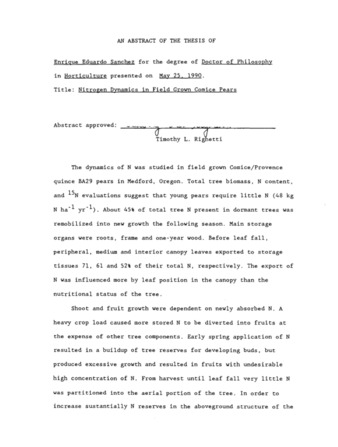Ver ítem
- xmlui.general.dspace_homeCentros Regionales y EEAsCentro Regional Patagonia NorteEEA Alto ValleTesisxmlui.ArtifactBrowser.ItemViewer.trail
Nitrogen dynamics in field grown comice pears
Resumen
The dynamics of N was studied in field grown Comice/Provence quince BA29 pears in Medford, Oregon. Total tree biomass, N content, and ¹⁵N evaluations suggest that young pears require little N (48 kg N ha⁻¹ yr⁻¹). About 45% of total tree N present in dormant trees was remobilized into new growth the following season. Main storage organs were roots, frame and one-year wood. Before leaf fall, peripheral, medium and interior canopy leaves exported to storage
[ver mas...]
The dynamics of N was studied in field grown Comice/Provence quince BA29 pears in Medford, Oregon. Total tree biomass, N content, and ¹⁵N evaluations suggest that young pears require little N (48 kg N ha⁻¹ yr⁻¹). About 45% of total tree N present in dormant trees was remobilized into new growth the following season. Main storage organs were roots, frame and one-year wood. Before leaf fall, peripheral, medium and interior canopy leaves exported to storage tissues 71, 61 and 52% of their total N, respectively. The export of N was influenced more by leaf position in the canopy than the nutritional status of the tree. Shoot and fruit growth were dependent on newly absorbed N. A heavy crop load caused more stored N to be diverted into fruits at the expense of other tree components. Early spring application of N resulted in a buildup of tree reserves for developing buds, but produced excessive growth and resulted in fruits with undesirable high concentration of N. From harvest until leaf fall very little N was partitioned into the aerial portion of the tree. In order to increase sustantially N reserves in the aboveground structure of the tree, and avoid excessive shoot growth and high N fruits, N should be applied 3-6 weeks before harvest. When N was applied at or after harvest but before leaf fall, roots were primarily the site of N storage. At that time 5 or 10% postharvest urea spray was the only effective way to obtain labelled N in flower buds. Early spring growth normally depended on N reserves. However when temperature around bloom was warmer than the long term average newly absorbed N was translocated to the flowers. During the first 3-4 weeks after bloom newly absorbed N was partitioned to spur leaves while shoot leaves were more dependent on stored N. Once spur leaves reached full expansion N was diverted into shoot leaves and fruits. Fruits from the same tree varied considerable in N concentration especially when fertilizer N was applied after bloom. Trees with high N status discriminated in the allocation of N to fruit in different canopy positions but trees with low N status did not. Large number of fruits in any specific location lessened N concentrations. The location of the fruit in the canopy only partially explains N variability. Similar sized fruits only a few centimeters apart may have a two fold concentration range.
[Cerrar]

Director de Tesis
Righetti, Timothy L.;
Descripción
Tesis para obtener el grado de Doctor of Philosophy (Ph.D.), de la Oregon State University, en mayo de 1990
Fecha
1990-05
Editorial
Oregon State University
Formato
pdf
Tipo de documento
tesis doctoral
Palabras Claves
Derechos de acceso
Abierto
 Excepto donde se diga explicitamente, este item se publica bajo la siguiente descripción: Creative Commons Attribution-NonCommercial-ShareAlike 2.5 Unported (CC BY-NC-SA 2.5)
Excepto donde se diga explicitamente, este item se publica bajo la siguiente descripción: Creative Commons Attribution-NonCommercial-ShareAlike 2.5 Unported (CC BY-NC-SA 2.5)


